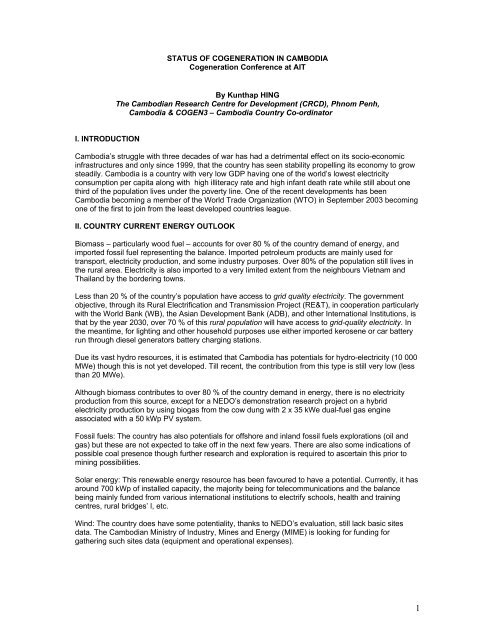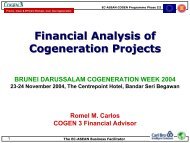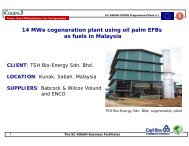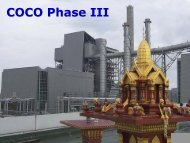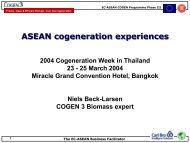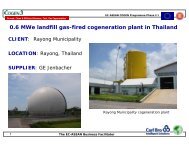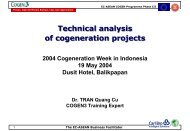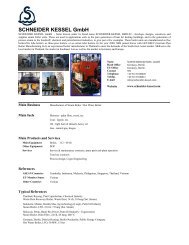STATUS OF COGENERATION IN CAMBODIA ... - cogen 3
STATUS OF COGENERATION IN CAMBODIA ... - cogen 3
STATUS OF COGENERATION IN CAMBODIA ... - cogen 3
You also want an ePaper? Increase the reach of your titles
YUMPU automatically turns print PDFs into web optimized ePapers that Google loves.
<strong>STATUS</strong> <strong>OF</strong> <strong>COGENERATION</strong> <strong>IN</strong> <strong>CAMBODIA</strong>Cogeneration Conference at AITBy Kunthap H<strong>IN</strong>GThe Cambodian Research Centre for Development (CRCD), Phnom Penh,Cambodia & COGEN3 – Cambodia Country Co-ordinatorI. <strong>IN</strong>TRODUCTIONCambodia’s struggle with three decades of war has had a detrimental effect on its socio-economicinfrastructures and only since 1999, that the country has seen stability propelling its economy to growsteadily. Cambodia is a country with very low GDP having one of the world’s lowest electricityconsumption per capita along with high illiteracy rate and high infant death rate while still about onethird of the population lives under the poverty line. One of the recent developments has beenCambodia becoming a member of the World Trade Organization (WTO) in September 2003 becomingone of the first to join from the least developed countries league.II. COUNTRY CURRENT ENERGY OUTLOOKBiomass – particularly wood fuel – accounts for over 80 % of the country demand of energy, andimported fossil fuel representing the balance. Imported petroleum products are mainly used fortransport, electricity production, and some industry purposes. Over 80% of the population still lives inthe rural area. Electricity is also imported to a very limited extent from the neighbours Vietnam andThailand by the bordering towns.Less than 20 % of the country’s population have access to grid quality electricity. The governmentobjective, through its Rural Electrification and Transmission Project (RE&T), in cooperation particularlywith the World Bank (WB), the Asian Development Bank (ADB), and other International Institutions, isthat by the year 2030, over 70 % of this rural population will have access to grid-quality electricity. Inthe meantime, for lighting and other household purposes use either imported kerosene or car batteryrun through diesel generators battery charging stations.Due its vast hydro resources, it is estimated that Cambodia has potentials for hydro-electricity (10 000MWe) though this is not yet developed. Till recent, the contribution from this type is still very low (lessthan 20 MWe).Although biomass contributes to over 80 % of the country demand in energy, there is no electricityproduction from this source, except for a NEDO’s demonstration research project on a hybridelectricity production by using biogas from the cow dung with 2 x 35 kWe dual-fuel gas engineassociated with a 50 kWp PV system.Fossil fuels: The country has also potentials for offshore and inland fossil fuels explorations (oil andgas) but these are not expected to take off in the next few years. There are also some indications ofpossible coal presence though further research and exploration is required to ascertain this prior tomining possibilities.Solar energy: This renewable energy resource has been favoured to have a potential. Currently, it hasaround 700 kWp of installed capacity, the majority being for telecommunications and the balancebeing mainly funded from various international institutions to electrify schools, health and trainingcentres, rural bridges’ l, etc.Wind: The country does have some potentiality, thanks to NEDO’s evaluation, still lack basic sitesdata. The Cambodian Ministry of Industry, Mines and Energy (MIME) is looking for funding forgathering such sites data (equipment and operational expenses).1
For the renewable energy technologies (RET), particularly for mini/micro hydro and solar, theGovernment/WB, in the RE&T project, has set a goal – with phased implementation - for the nextcoming five-year period for achieving:- 5 % or 6 MWe of generating capacity with RET, including 3 hydropower mini-grids, 3 viableRET businesses and 50-100 trained RET personnel.- At least 10 000 households (HH) served by solar home systems (SHS).- 45 000 HH in rural areas will be electrified during this period.III. <strong>STATUS</strong> <strong>OF</strong> <strong>COGENERATION</strong>Today, there is still no existing <strong>cogen</strong>eration facility in Cambodia as such. In the recent andcontemporary history of Cambodia, the <strong>cogen</strong>eration concept was re-introduced in August 2002 only,thanks to the EC ASEAN Cogeneration Programme, Phase III (Cogen3). Cogeneration is said to havebeen existing in the sugar mills in the 1960s though there are no official records to confirm this.In the early 2003, since Cambodia did not have or use coal and natural gas, Cogen3 evaluated twobiomass <strong>cogen</strong>eration projects, one for a palm oil and one for a rice mill. Finally Angkor Rice’s 1.5MWe power plant using rice husk as fuel to generate both heat and electricity, has been chosen to beimplemented using European equipment including a partial investment funding from the EuropeanCommission. The project is expected to be completed or in operation before the end of the year 2004.However, it is worth mentioning that, programmes like EC-ASEAN Cogen3 has been making a lot ofcontribution in capacity building activities among the Cambodian Policy Makers (government andprivate sector) through the ASEAN & EU workshops and study with a primary aim to train Cambodianengineers and economists in technical, financial and environmental <strong>cogen</strong>eration project evaluation.OTHER <strong>COGENERATION</strong> POSSIBILITIESOther than the fuels mentioned previously, there exist <strong>cogen</strong>eration potentials, particularly in hotels,hospitals, textile factories, airports, etc. Also some of the identified sectors for <strong>cogen</strong>eration arementioned as follows:- Rice husk (the main and staple crop for Cambodia, with a potential of 0.82 million ton of rice husk,i.e. 270 000 tons of oil equivalent (TOE) ;- Wood waste from saw mills and plywood factories;- Sugar cane bagasse from Kompong Cham (N-E), Kandal (near Phnom Penh) and Pursat (N-W);- Waste from cashew nut and- Wastes from palm oil factories.BARRIERS FOR <strong>COGENERATION</strong> <strong>IN</strong> GENERAL AND FOR <strong>COGENERATION</strong> US<strong>IN</strong>G BIOMASS:- Lack of institutional policies to promote efficient energy production like <strong>cogen</strong>eration and otherrenewable energy resources.- Access to Banking/Financing/MFI (Micro Financing Institution) of RET: The banking andfinancing activities for Small and Medium Enterprise (SME) – one of the pillars for ensuring thesuccessful implementation of Rural Electrification projects - belong to a relatively immaturefinancial sector, which still lacks an acceptable legal framework. “A lack of borrower andlender confidence and the laxity of the legal system, mean the sector which is increasinglyseen as the key to economic growth”. “Practicing a very high interest rate for short term, andsmall loans requiring very high equity share” cannot be compatible for any businessdevelopment. The whole banking, financing, MFI institutional and legal frameworks – as wellthe Judiciary system – would need to be upgraded.- Lack of information on market characteristics and resource potential & especially itsavailability: for example, a detailed market assessment is needed to evaluate the prospects ofa renewable energy (biomass, for example) as a viable alternative to diesel oil stations orbatteries in different districts of the Kingdom.2
NOTE concerning the barriers:The Royal Government of Cambodia (RGC) does have a constant interest in the promotion of theRET. Indeed, the “RGC formulated a national energy policy sector in October 1994, its objective beingto provide a secure, reliable, environmentally safe, and sustainable energy supply from various forms,at reasonable and affordable price, in order to address the population as well the economicdevelopment needs of the Kingdom. In this respect, it encourages the exploration and development ofall national resources, which are socially and environmentally acceptable to the national communities,and the efficient use of energy and energy conservation. The current policy statement on ruralrenewable electricity is a reaffirmation of the earlier Policy, and the extension of the commitment onthe part of the RGC”. Currently, the Ministry of Industry, Mines and Energy (MIME), in co-operationwith the World Bank, practically achieves the National Policy, Strategy & Action Plan on RenewableEnergy – based Rural Electrification in Cambodia, with main emphasis on PV and micro/mini hydro.Lately, thanks indirectly to Cogen3 awareness campaigns on the benefits of <strong>cogen</strong>eration usingbiomass as primary fuel, we hope biomass could be considered as an eligible candidate for the next 5-year RGC/World Bank RET implementation Action Plan. All this, once finished, will be submitted tothe RGC for approval.IV. CONCLUSIONNOTE: To conclude the <strong>cogen</strong>eration trends in Cambodia, the following excerpts from the RGC’s“National Policy on Renewable Energy – based Rural Electrification” dated 25 th June 2003 have beenmentioned below:“Providing clean, reliable, safe and cost-effective electricity services, based primarily on renewableresources, to rural areas in a fair and equitable way is a major challenge and an opportunity that boththe Kingdom of Cambodia and the World Community shall address together in the context of povertyreduction and global climate change.. Small power sources including those based on renewableresources offer a major alternative to fossil fuels in meeting this challenge. However, the serioussocio-economic, techno-financial and policy-institutional barriers to be overcome this challengeexceed by far the capacity of one of the poorest populations in the region. The RGC looks to theInternational Community for assistance in organizing the promotion of clean electricity to rural areas,especially in the initial period, as the benefits are local and global.This policy statement addresses various aspects of supply of rural renewable electricity services andlays down broad guidelines for the program. These guidelines also endeavour to take into account therequirements of international donors, from whom the initial human and financial resources are to bemobilized. In this respect it should be noted that motivation and commitment of all public and privatesector stakeholders is one of the basic ingredients for a sustainable development of clean electricitysupply to rural areas, and RGC shall strive to ensure this commitment through the design of aneffective program and appropriate incentives.In order to make this policy effective in the short and long run, all the ministries/ institutions concernedin the government and its agencies, and other stakeholders, shall actively be involved in a coordinatedway in making operational the guidelines provided in the statement. Therefore, the Royal Governmentof Cambodia, playing its role of market enabler and regulator, and as a guardian of social justice andequity, shall endeavour to make every effort to implement this policy to the greater benefit of thenational community”.Cogeneration in general, and <strong>cogen</strong>eration using biomass in particular, are one of the mostefficient, economically cheap and environmentally sustainable solutions, the Internationalcommunities should help the RGC in addressing the through rural electrification to provide afoundation to a bright economic future.3


